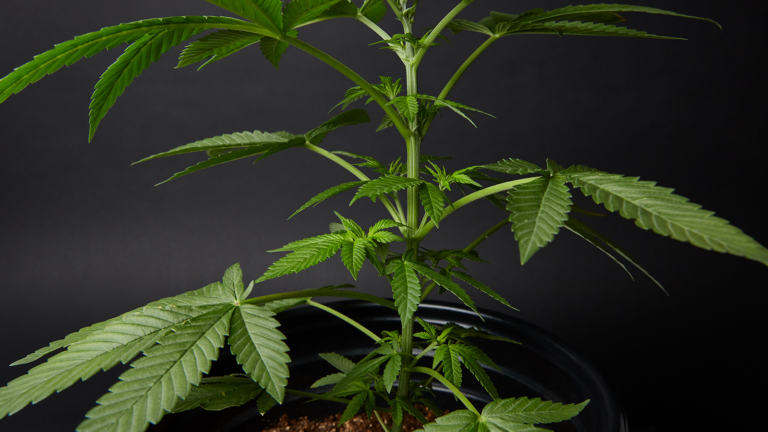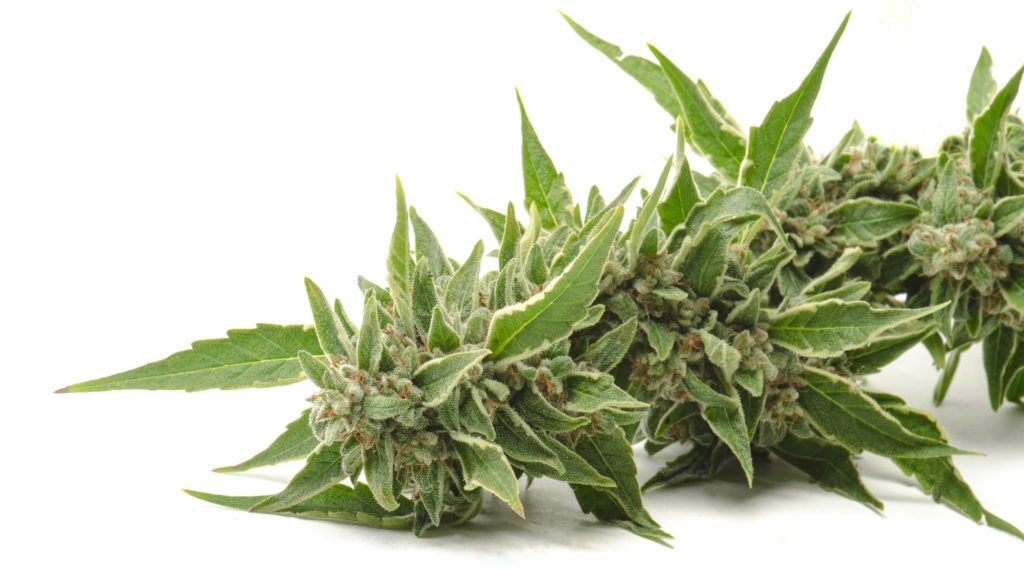Cannabis grows in a variety of climates around the world and can be used in many applications: rope, biofuel, paper, and many medical and recreational uses. The plant is part of the Cannabaceae family, which also includes hops. It is further classified as Cannabis sativa L. Each part of the plant serves a purpose and while the whole of a cannabis plant is certainly greater than the sum of its parts, knowing its parts can inform your experience and appreciation of it. Below are descriptions of each of the plant's parts and the functions they perform.

Image lightbox

Flower
The flowers of the female marijuana plant can be identified by their small teardrop structures, which consist of pistils attached to bracts. Cannabis flowers are usually covered with a frosty-looking coating of trichomes, with a heavier density of trichomes making for a more desirable flower.
Cola
The main part of the flower, at the end of a female plant's stem is composed of many small floral clusters. In general, the bigger, heavier, and more densely covered in trichomes a cola is, the better quality it will be, although some cultivars will naturally grow flowers that are more loosely structured and airy.
Bracts
The small leaves that surround the reproductive cells of a female weed plant. When a female plant is exposed to pollen from a male marijuana plant, the bracts surround and shield the seed pod.
Trichomes
Marijuana trichomes are hairlike appendages found on the surface of the cannabis plant. Trichomes protect the plant from external stressors and contain resinous glands that create flavonoids, cannabinoids and terpenes — the chemical compounds that give the marijuana plant its unique features and effects. Trichomes give cannabis buds a crystal-like sheen and make them sticky feeling.
Within the glandular trichomes, there are three main types: bulbous, capitate-sessile and capitate-stalked.
Non-glandular trichomes are called cystoliths. Bulbous trichomes are tiny bulbs that are sparsely located throughout the entire plant, but are so small they can't be seen with the naked eye. Capitate-sessile trichomes are more abundant than bulbous trichomes, found on the underside of the sugar leaves and fan leaves, but are usually only visible through a microscope. Capitate-stalked trichomes are shaped like mushrooms and contain a large trichome head at the top of the stalk. These are the trichomes that can be easily seen on the cannabis flower surface.
Node
The point at which the stem and leaf intersect. Nodes can hold one or more leaves or offshoots. As explained below, nodes are important to be familiar with, as they are where cannabis plants begin to grow either pollen sacs (male cannabis plants) or pistils (female cannabis plants). Understanding the sex of a marijuana plant is crucial to the final product, since only female plants produce flowers and since non-pollinated flowers are far superior than pollinated buds when it comes to consumption.
Fan leaves
Leaves are important components of a weed plant, and there are actually a couple types of marijuana leaves. The large, protruding leaves that appear along the length of the plant are called fan leaves. Theses leaves are essential to the living plant's photosynthesis, but are always removed from the finished, harvested product.
Sugar leaves
As opposed to fan leaves, sugar leaves are small leaves found throughout cannabis colas' cupping buds that are typically trimmed off the flower after harvest. They are called “sugar leaves” because of the high volume of trichomes found on them, which makes it look like the leaves are covered in sugar. Sugar leaf trim can be used to make edibles or concentrates.
Stem
The main support structure of the marijuana plant, the stem transports fluids, nutrients, and information from the roots to the rest of the weed plant. The stem provides a foundation to give fan leaves access to the light they need to facilitate growth and carries the weight of heavy colas.
Pistils vs. stigmas
There is often a lot of confusion surrounding pistils and stigmas, with many people confusing one of the other. Here's a quick breakdown on the difference between the two important cannabis plant components.
What is a pistil?
The pistil is the primary piece of the female flower's reproductive system, comprising a single ovule with two protruding stigmas.
What are stigmas?
The thin hairs that extend from a female's bract to catch male pollen. They are commonly confused with pistils. Knowing how to identify stigmas is an important part of growing weed, as these are the telltale signs that a plant is female and will therefore produce the cannabinoid-rich flowers you're trying to harvest.
 Photo by: Gina Coleman/Weedmaps
Photo by: Gina Coleman/WeedmapsImage lightbox

Types of weed plants
If you want to stay in touch with the origins of your favorite cannabis products, knowing the ins and outs of the plant at the industry's core is a good place to start. And that includes knowing not only the specific parts of a cannabis plant, but also the different types and strains of weed that exist.
Along with understanding the various parts of a marijuana plant, you should also know about the different types of cannabis. While there are long-held claims about the effects that sativas, indicas, and hybrids offer, current research suggests that the effects of cannabis are determined by a person's endocannabinoid system and the plant-specific cannabinoid profile.
Despite that, cannabis is typically classified in the following four categories:
- Indica: Indica-leaning weed plants tend to produce dense, fat, heavy buds during the flowering stage. These strains are typically believed to give consumers a “body high” instead of a more cerebral high.
- Sativa: Sativa plants tend to produce buds that are airy and more formed than indica plants. Sativa strains of the weed plant are often said to offer users a more cerebral, energetic, “buzzy” highs.
- Hybrid: As a blend of sativa and indica, hybrid strains are generally believed to give you a more balanced high.
- Hemp: Hemp plants are part of the cannabis family, but they differ from a regular weed plant in that they produce only trace amounts of THC, the cannabinoid responsible for the intoxicating effects of the marijuana plant. In the U.S., the 2018 Farm Bill specified hemp as a cannabis plant containing up to 0.3% THC. However, hemp plants produce a number of other important cannabinoids, most notably cannabidiol (CBD), and their fibers are used to produce a range of textiles.
To break it down even further, there are numerous strains within each of the more general categories indica, sativa, and hybrid. Understanding and becoming familiar with these various strains is what will really enable you to target — on a specific level — the type of experience you have when consuming weed.
How to tell male from female marijuana plants
Typically, you will be able to distinguish between male and female cannabis plants when the plant is about six weeks old. To figure out the sex of a marijuana plant, look at the plant's nodes, where the leaves and branches connect to the main stem.
Male plants will produce pollen sacs that at first look like little tiny balls and then grow into larger clusters of oblong-shaped sacs. Conversely, a female weed plant will produce pistils, which in their early stages look like thin hairs and then eventually start growing into more structured ovules and stigmas.
 Photo by: Gina Coleman/Weedmaps
Photo by: Gina Coleman/WeedmapsImage lightbox

There is one very important reason why it's crucial to be able to distinguish male from female plants: Only female plants produce flowers. Because male plants produce pollen sacs, they do not generate any of the buds that people actually harvest and consume. From the perspective of growing weed for human consumption, male plants are really only good for propagating brand new baby plants from seed.
With the exception of consciously choosing to reproduce plants through pollination (as opposed to cloning a female plant), growers must carefully keep male plants away from female plants.
Hermaphrodite plants are a rare monecious plant, meaning it develops both male and female sex organs. Hermaphrodites are primarily formed if a female weed plant is exposed to extreme conditions during key stages of growth. Flowers from hermaphrodite plants will be full of seeds, making them very poor quality for consumption. To avoid this, growers must be experts at spotting both hermaphrodite and male plants early and then getting rid of them before they ruin nearby female plants.
Many breeders produce seeds that are feminized as a way to avoid male genetics. These feminized seeds only carry female genetics, and in most cases, is guaranteed to produce female plants. Another option is to grow auto-flowering strains, which are genetically engineered to automatically flower after a brief vegetative period of two to four weeks.
How to propagate cannabis plants
Knowing the parts of a marijuana plant is necessary for propagating cannabis plants. Propagation refers to the process of using one plant to create new plants. In general, cannabis growers do this in one of two ways:
- Cloning: Cloning is a popular method, as it allows you to get multiple baby plants from a single adult plant, without having to buy seeds or go through the longer process of germinating, planting, and growing a weed plant from seed. To clone a marijuana plant, carefully cut a branch away from the stem right at the node. From there, place the cutting into a growing medium, typically either suspended in water or inserted into a starter plug. When the cutting develops roots you can then transplant it into a larger container or the ground, depending on where you're going to be growing the plant.
- Seeds: Growing from seed requires you to start from scratch, and is ideally suited to growers who are novices, growers who want to produce a new type or strain than what they're already growing, and growers who don't have a plant they want to replicate exactly. To grow a weed plant from seed, place a seed in some sort of starting medium such as rockwool or peat pellets and keep it moist until it sprouts. As the sprout develops leaves and roots, it will start requiring more and more light. When a decent little ball of roots has formed, transplant the baby marijuana plant to a larger container or the ground and proceed to feed, water, and ventilate it until the weed plant reaches maturity.

